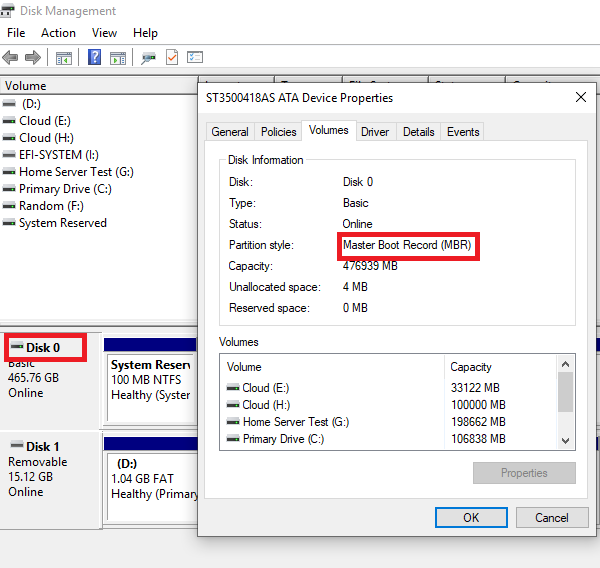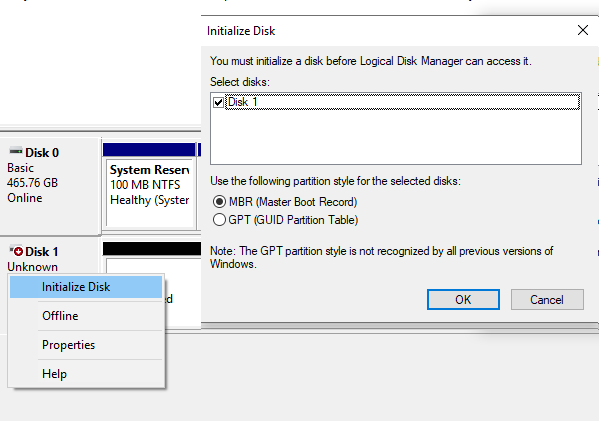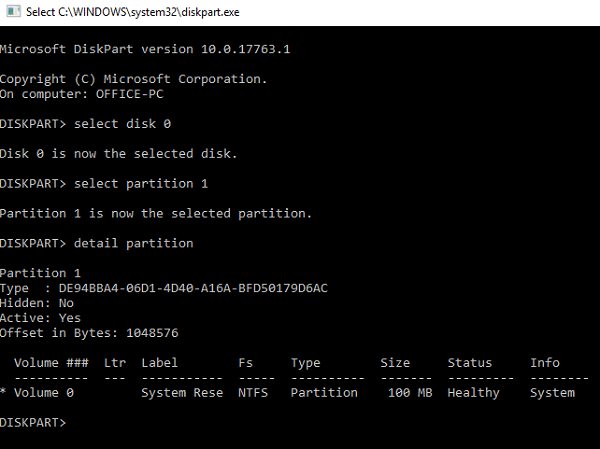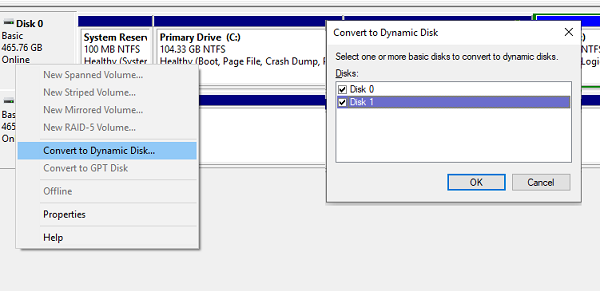This guide walks you through steps to help you mirror the Boot Hard drive on Windows (Legacy or UEFI). This is useful when the primary hard drive fails and will help you boot from the secondary drive. Before we go ahead and talk about the steps, a few conditions should be fulfilled.
Minimum requirement to mirror Boot Hard Drive on Windows 11/10
- Make sure to choose to a second drive which is the same size as the drive you want to mirror.
- Identify if you are using a LEGACY or UEFI. Methods for both of them differ.
- Disable hibernation on the computer using powercfg.exe /h off
Mirror Boot Hard Drive for UEFI partition in Windows 11/10
Assuming you are clear with the type of drive, let’s understand how to identify if you own a Legacy or UEFI based system. While the Legacy system uses MBR Partition Style, a UEFI system uses GPT Partition style.
Find Partition Style – MBR or GPT

Type diskmgmt.msc in Start search box and hit the Enter key to launch Disk Management.
Right-click on Disk 0 and select Properties.
Switch to Volumes tab, and note the partition style
In Volumes tab, check the Partition Style of the volume.
- If it is Master Partition Record, then you have a legacy-based computer.
- In case it is GUID Partition Table, then you own a UEFI-based system.
If the secondary disk has not been set up, connect it and then initialize the hard drive. Make sure to use MBR as the partition style when initializing it. This will ensure consistency between the disks. Also, create an allocated disk and assign space that is the same as or more than the C drive of Disk 0.

If you cannot initialize the hard drive, check on how you can do it for standard disk and for USB 3.0 drives.
Next, follow the part of the tutorial based on your Partition Style.
Mirror Windows Boot Drive on UEFI or GPT Partition Style
It takes three steps to mirror Windows Boot drive, which is on a UEFI system. You need first to mirror the recovery partition, then the EFI system partition, and then the operating system partition. Make sure you understand the disk management commands entirely before we go ahead.
Open Command Prompt, and then type diskpart command, and hit Enter. Diskpart will open in a new prompt for the rest of the operation.
There are two assumptions here.
- DISK 0 is your primary drive, and DISK 1 is the secondary drive.
- Your hard disk has Recovery, System, Reserved and Primary partitions.
Follow these steps to mirror the Recovery Partition
1] Find the TYPE id and the size of the partition of Disk 0
Run the following command in an elevated Command Prompt, one after the other, until you see the partition details.
select disk 0 select partition 1 detail partition

2] Convert the Secondary disk or DISK 1 to GPT & Copy content.
Here we have to make sure to convert the drive into GPT partition style, create a Recovery Partition of the same size, and then copy the content of the Disk 0 partition to Disk 1.
Create a primary recovery partition size-
select disk 1 convert gpt select partition 1 delete partition override create partition EFI size=100
Format and Set ID for Disk 1 primary recovery partition-
format fs=ntfs quick label=Recovery select partition 1 set id=DE94BBA4-06D1-4D40-A16A-BFD50179D6AC
The size and ID should be the same as the DISK 0
Assign the letter for the primary recovery partition-
select disk 0 select partition 1 assign letter=q select disk 1 select partition 1 assign letter=z exit
Exit after the operation is complete.
Lastly, you need to copy the content of the primary recovery partition of Disk 0 to the primary recovery partition on disk 1. Use the following command-
robocopy.exe q:\ z:\ * /e /copyall /dcopy:t /xd "System Volume Information"
Assuming Q is the letter of the active partition on Disk 1, and Z is on Disk 2.
Steps to mirror the EFI System Partition
1] Find the size of System & Reserved Partition in Disk 0
In the dispart prompt, type select disk 0, and then type list partition. It will show all the partitions along with their size. Note down the size of both the System and the Reserved Partition.
Let’s assume the System or EFI size is 99 MB and the reserved partition size is 16 MB
2] Create the System and Reserved partition on Disk 1
select disk 1 create partition EFI size=99 format fs=fat32 quick assign letter= Y create partition MSR size=16
3] Copy files from DISK 0 to Disk 1
Since we need to copy the file from the System and Reserved partition of Disk 0 to Disk 1, we will have to assign the letters on Disk 0 as well. First, use select disk 0, select partition 2, and then assign letter=S command in the CMD. Next, use the robocopy command.
robocopy.exe S:\ Y:\ * /e /copyall /dcopy:t /xf BCD.* /xd "System Volume Information"
Steps to Mirror the OS Partition on Windows 11/10

Since both the partition is the same in all parameters, it’s time to open the Disk Management UI and perform the final mirror.
- Right-click on Disk 0, and select Convert to Dynamic Disk.
- It will open the converter; you can choose Disk 0 and Disk 1. Click ok.
- Finally, right, click at C drive/volume on Disk 0 and select Add Mirror
- Select Disk 0, then decide on the space you want to allocate. It has to be equal to the size of the C drive.
- Follow the wizard until it’s complete.
Regarding GPT, mirroring is relatively complicated compared to how it is on Legacy Based Devices, which comes next.
Read: How to use HP PC Hardware Diagnostics UEFI on Windows
Mirror Windows Boot Drive on Legacy-Based Systems or MBR Partition Style
This post will show you how to create mirrored Windows 10 Boot Drive on Legacy Based Systems. During the process, if you notice that the Add Mirror option is greyed out, it means that the unallocated space on the secondary drive is smaller than the boot drive. You can shrink the size to make it equal.
Remember that mirroring ensures your system keeps running if your first partition fails. It is not a backup solution.
Leave a Reply